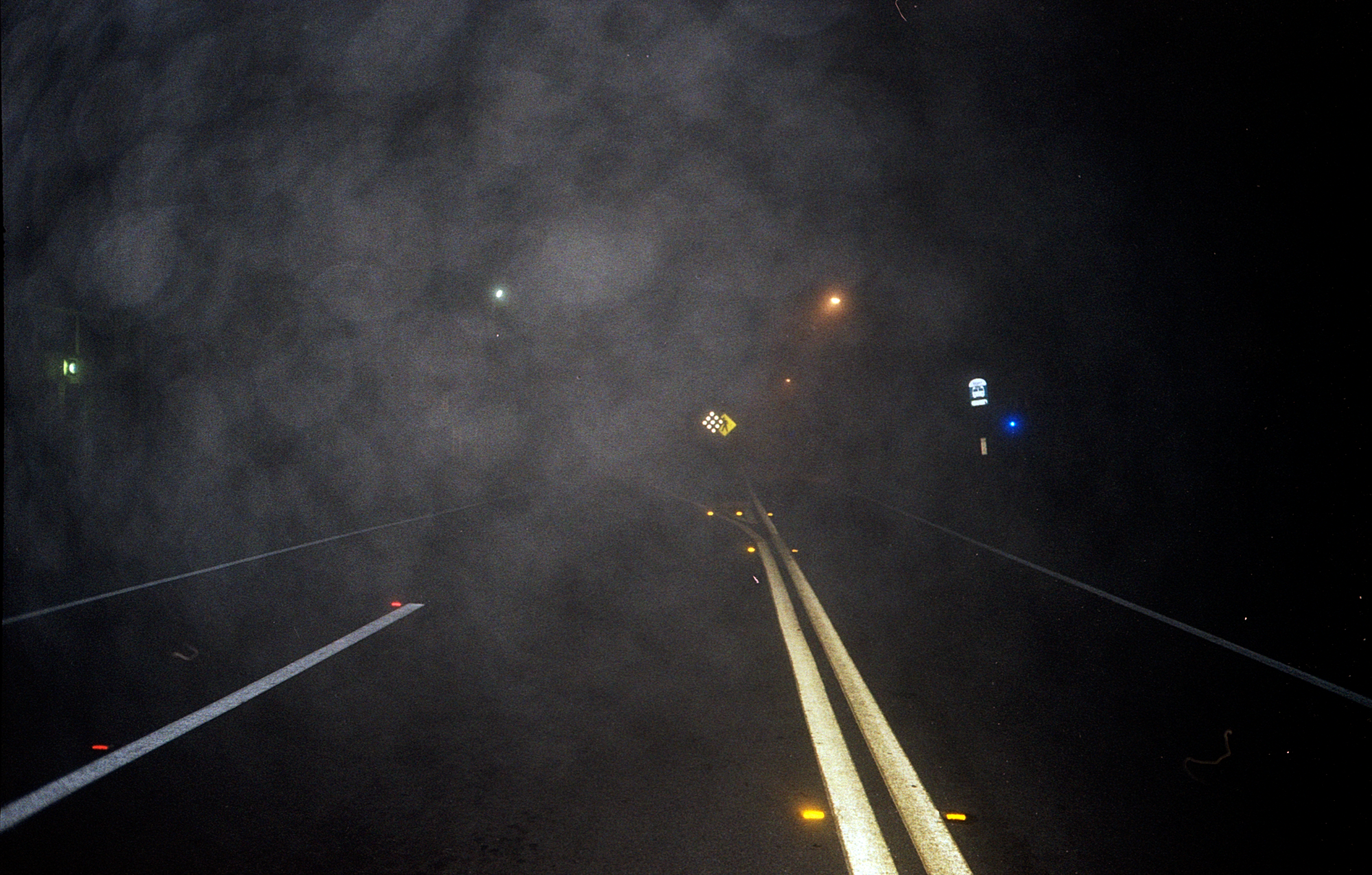Photo Credit: Frances Bukovsky
I Want a Doctor Who is a Photographer
Frances Bukovsky
I want a neuro-opthamologist who speaks a photographic visual language, a doctor who grasps the terminology that I cannot untangle from the descriptions of my vision even as I try my hardest not to speak of ISO. To clarify, not a photographer in the sense that they spend top dollar for the latest sensors and find entertainment on lens forums arguing about the best brand of camera, though they might do that. What I am asking for is someone who understands me when I describe how I see.
I imagine myself sitting in a darkened room (with an orange safelight-esque glow from the dimmed lights) describing my vision through photographic descriptions. I speak of clipped highlights, as if I forgot what film speed they loaded and was metering two stops over the optimal tonal range. I’ve got 3200 speed in broad daylight, a whirl of grain obliterating detail and applying a nervous jitter into my field of vision.
I speak of punctures in my vision, as if something damaged the film in development, the small black void rimmed with a luminescent edge, like a small eclipse that vanishes as quickly as it appears. When I describe the way vintage lenses create a particular swirling bokeh that is both beautiful and disorienting, the doctor nods, an image of their own coming to mind.
I have a million and one phrases for the peculiarities of my vision, like the way everything seems offset by a handful of pixels, creating not quite double-vision, but one-and-a-half vision. The floaters before me become chemical stains on large format film that wasn’t agitated evenly. In my mind’s eye the doctor understands, not because they’ve seen what I see with their own eyes, but because our shared language fosters an understanding that a textbook definition fails to grasp.
In my years as a patient in the medical system, the span of time which contains the bulk of my life, I have come to an acute understanding of the relationship between a doctor’s understanding of the impact of a condition on my life and their approach in treating it. When I relate my symptoms to specific tasks, there is a story that is created rather than disparate details. Somewhat contradictory, I also have come to an understanding about the limitations of medicine, and that sometimes there is no understanding to be gained or treatment to be had. What I am focusing on here is how the language used to describe an experience might foster compassion and insight to motivate research and intervention.
The textbook definition of Visual Snow Syndrome as quoted from NORD is: “...a neurological disorder characterized by a continuous visual disturbance that occupies the entire visual field and is described as tiny flickering dots that resemble the noise of a detuned analogue television.”
NORD goes on to describe this condition as uncommon, though the exact prevalence in the general population is unknown due to a general lack of recognition by providers. They mention that this lack of recognition has impacted research, making understanding of the condition poor, and there are no clinically studied treatments available.
A detuned analogue television is the metaphor I used when speaking with the neuro-opthamologist my neurologist referred me to in order to rule out optic neuritis. After an examination of the structure of my eye, and a 20/20 vision test (ironic as I have a hard time processing visual information easily on a regular basis) he diagnosed me with visual snow. Interestingly enough in that exchange he asked me if as a photographer I could recreate my visual field in an image. Unfortunately due to Covid and an expensive copayment, the follow up appointment never occurred.
I wonder what the difference would have been if I had gone back with an array of images I had made on expired, underexposed film scratched and dusty, subjects rendered in a painterly fashion on the emulsion. Surely nothing in my treatment plan, since as I have mentioned there are no treatments. I left the doctor’s office with the assurance from him that I “wouldn’t lose my vision,” and I felt a little internal apprehension at his assertion. My vision is altered, perhaps not lost, but the reality I see looks different than it did even 3 years ago, and it continues to morph.
His words of what he intended as reassurance came back to me one night as I hurtled, white knuckled, through a column of orange barrels with lights on the top of them. The light rain made the new road slick and as reflective as a mirror. The taillights of traffic in front of me and headlights behind me turned the world into a funhouse horror show, palinopsia creating triples of each light source while nyctalopia threatened to obscure my lifeline, the white line to the left of the car. My hotel for the evening was less than 10 miles away and my already ordinarily dry mouth was a bed of cotton as I tried to keep my visual disorientation from generating panic.
Visual snow can be worsened by fatigue, and after driving for 12 hours my brain felt weary of processing visual information. I wondered if the doctor meant that VSS wouldn’t become disabling for me when he mentioned that I wouldn’t experience vision loss, but as a 25 year old who began having an aversion to driving in the dark when it rains, I wondered if he understood the impact of my visual changes on my daily life.
To extend fairness to the doctor, we met once, and spoke for less than 20 minutes. A complete understanding couldn’t have been fostered within that brief encounter, though I do wonder about what advice I may have left with if there had been a shared understanding of experience. My visual changes aren't seen as a problem because I still test at 20/20 vision, regardless that I am tested in a quiet, dim room and given as much time as I want to puzzle out the dancing double exposures at the far end of the room.
In the real world I have fluctuating limitations that depend on a myriad of factors. Add in chronic dry eye and intermittent migraine auras from chronic migraines and on my worst days the world is searingly bright, locked away behind smeared glass and grainy emulsions. A busy scene full of repeating patterns, such as an intricate mural as I’m walking down the street can cause me to hesitate, unsure of precisely what I’m seeing.
As a photographer and visual artist, the changes to my vision appear as a heightened sensitivity to light, changing ever so slightly my relationship to the camera. Auto-focus is an assistive device as someone who cannot tell where the sharp edge of something is. The images I make often do not reflect the vision that I see, though they describe a reality I find myself dancing at the edge of. There are moments in my practice however, when artistic medium and visual reality coincide and I find myself staring at an image, a slice of the ocular world I inhabit existing outside of my biology.
At the end of the day, does it matter what language I’ve used for my eyesight? There is no quantifying my experience currently, no cure, not even tested treatments. Does it matter if my doctor is sympathetic or skeptical?
I know with the core of my being however, that it does. It is important to have a shared language in order to have common understanding. Within the words exchanged a condition becomes less a textbook definition and more a life altering experience worthy of the precious research dollars that are always in short supply. It is through the language that I become less a patient with Visual Snow Syndrome and more a human who sees the world through overexposed, dirty film.
Frances Bukovsky (b. 1996, they/them) is a fine art documentary photographer thinking about chronic illness, disability, and queerness as these topics relate to selfhood, relationships, and medical experiences. They utilize self portraiture, documentary style photography, and alternative process prints to approach their dynamic and fluid experience of both illness and gender identity. Bukovsky earned a BFA with Honors in Photography and Imaging from Ringling College of Art and Design in 2018. Since then, they have been published internationally for their work on chronic illness, including a feature in Archer Magazine’s Disability issue. They have also exhibited work in group shows such as Witness at Texas Technology Institute curated by Efrem-Zelony Mindell, and If We Never Get Better at TILT curated by Sydney Ellison. Bukovsky’s debut monograph, Vessel, was published by Fifth Wheel Press in 2020.
Besides their personal art practice, Bukovsky participates in community building around photography. In 2020 they became a part of the founding team at Life at Six Feet, a photography project born out of a need for connection during the Covid-19 pandemic. That project has since evolved into the Kinship Photography Collective which explores the intimate connections between nature, culture, and belonging. Bukovsky is a photography instructor who seasonally directs the darkroom at AGBU's Camp Nubar, as well as offers workshops on making photographs from personal experience through various platforms. Outside of photography they have a deep rooted interest in the history and practice of medicine, from historical traditions of healing, to modern practices. They also have a vested interest in disability issues and does work as a respite care provider. When they aren’t making photographs, they can be found reading any book that catches their eye, wandering around the woods someplace, or getting lost in some place new.
Bukovsky is currently based in upstate New York.




